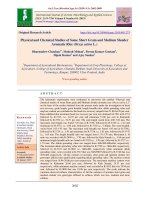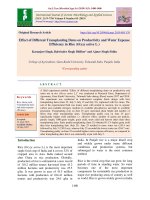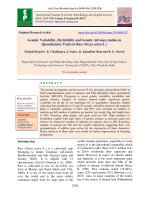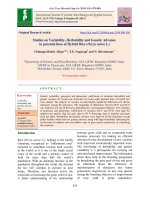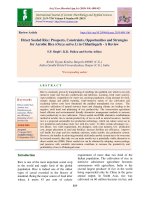Assessment of physiological traits for adaptation to flowering stage water deficit in rainfed lowland rice (Oryza sativa L.)
Bạn đang xem bản rút gọn của tài liệu. Xem và tải ngay bản đầy đủ của tài liệu tại đây (220.18 KB, 11 trang )
Int.J.Curr.Microbiol.App.Sci (2019) 8(10): 245-255
International Journal of Current Microbiology and Applied Sciences
ISSN: 2319-7706 Volume 8 Number 10 (2019)
Journal homepage:
Original Research Article
/>
Assessment of Physiological Traits for Adaptation to Flowering Stage
Water Deficit in Rainfed Lowland Rice (Oryza sativa L.)
Prabhasmita Shatpathy1, Arti2, Surendra Pratap Singh3,
Sanat Kumar Dwibedi4* and Abhiram Dash5
1
Department of Plant Physiology, Odisha University of Agriculture and Technology,
Bhubaneswar, Odisha, India
2
Department of Crop Physiology, Narendra Deva University of Agriculture and Technology,
Kumarganj, Faizabad, India
3
Department of Crop Physiology, Indian Institute of Sugarcane Research, Dilkusha
Raibareilley Road, Lucknow, Uttar Pradesh, India
4
Department of Agronomy, Odisha University of Agriculture and Technology, Bhubaneswar,
Odisha, India,
5
Department of Agricultural Statistics, Odisha University of Agriculture and Technology,
Bhubaneswar, Odisha, India
*Corresponding author
ABSTRACT
Keywords
Rice, Flowering
stage, Moisture
deficit,
Physiological and
biochemical traits
Article Info
Accepted:
04 September 2019
Available Online:
10 October 2019
Responses of 4 cultivars of rice viz. NDR-8002, TCA-48, IR-42 and BPT
5204 to varying levels of moisture deficit stress at flowering stage were
assessed in the plastic tubs for their relative tolerance to drought. Moisture
deficit adversely affected the apparent translocation rate, relative leaf water
content, total chlorophyll content and total soluble carbohydrate content,
while proline accumulation enhanced irrespective of varieties. Grain yield
decreased conspicuously in all the varieties in response to water stress.
Amongst the rice varieties, NDR-8002 and TCA-48 were noted to be
relatively more drought tolerant than other 2 cultivars on the basis of their
yield performance. The flowering stage in rice was found to be very critical
to moisture deficit stress.
Introduction
Drought and prolonged dry spells are worldwide problems that significantly influence the
grain quality and quantity. The situation has
been worsening with the ever burgeoning
global population and climate change
(HongBo et al., 2005). Rice, a semi aquatic
field crop is very much susceptible to deficit
water stress conditions (Tao et al., 2006; Yang
245
Int.J.Curr.Microbiol.App.Sci (2019) 8(10): 245-255
et al., 2008). Near about 50% of the world
production of rice is affected more or less by
drought (Bouman et al., 2005). In rainfed
areas such climatic aberrations are frequent
having far off consequences with dwindling
productivity. As stable and high yields of
rainfed lowland rice are highly essential for
food security in many of the subsistence
farming system in Asia (Cooper, 1999),
growing of rice in Eastern India in around 10
m ha under vulnerable rainfed lowland
farming situation is the greatest challenge
before us.
Drought at the flowering stage is highly
detrimental to rice plants. It hampers anthesis
and seed setting leading to higher spikelet
sterility and lower yield in rice (Ram et al.,
1988). It also reduces effective leaf area and
photosynthesis, thus plants have to depend on
pre-anthesis reserves which may impart
tolerance against internal water deficits
(Austin et al., 1980). Therefore, there is urgent
need to develop flowering stage drought
tolerant lines for rainfed lowlands. This
necessitated the characterization of different
physiological
or
morphological
traits
associated with flowering stage drought
tolerance in rainfed lowland rice.
Though plants have naturally evolved several
stress adoptive strategies, most of them relate
to survivability under stress. However, from
the agricultural point of view, any stress
adoptive strategy, drought stress in particular,
would be useful only if it is associated with
superior crop growth rates under a given
stressful environment (Kar et al., 2005). Such
adoptive types were traditionally selected
based on empirical screening methods that did
not always result in the expected increase in
productivity under water limited conditions.
To improve crop productivity, it is being
suggested that a ‘trait-based’ approach to be
adopted (Sheshshayee et al., 2003), which
would provide a strong impulse to the efforts
in assessing the genetic variability under
moisture deficit stress condition. The present
endeavour is an attempt to study the
physiological and biochemical changes
occurring due to drought during flowering
stage in rainfed lowland rice and to identify
the desirable physiological traits related to
drought resistance.
Materials and Methods
The current study was carried out in plastic
tubs at the experimental site of the Department
of Crop Physiology, Narendra Deva
University of Agriculture and Technology,
Kumarganj, Faizabad, Uttar Pradesh, India
during Kharif 2011 and 2012 as factorial
completely randomized design with four rice
varieties (viz. IR-42, NDR 8002, BPT 5204,
TCA-48) in 3 replications and 3 drought
treatments viz. 100% (saturated) available soil
moisture regime (SMR), 50% available SMR,
25% available SMR), which was imposed at
flowering stage. The native soil was sandy
loam with pH of 6.8 and available N, Olsen’s
P and available K were of 124, 18 and 220 kg
ha-1, respectively. Cold winter months with
occasional frost and hot and dry summers
have been the climatologic features in that
area. Seeds were directly sown in the plastic
tubs at equidistance. Thinning was done in
each tub after seedling emergence and only 10
healthy plants were maintained. Plants under
saturated condition were irrigated normally
but 50% and 25% ASM regimes were
maintained by withholding irrigation in tubs.
After 4 days of water withholding in tubs, soil
sampling was done periodically. After
weighing, samples were oven dried and
moisture content in soil was computed. When
moisture content in soil reached to 14.5% and
10.75% in 50% and 25% available SMR
treatments respectively, drought treatment was
terminated by irrigating the tubs. The
observations on different characters were
taken as per the following procedures.
246
Int.J.Curr.Microbiol.App.Sci (2019) 8(10): 245-255
supernatant was measured at 645 and 663 nm
on spectronic-20 using 80% acetone as blank.
Grain /Economic yield
Panicles of tagged plants were separated from
plant then grains were collected and weighed
with the help of electronic balance for finding
out the grain yield in g plant-1.
Apparent translocation rate
The amount of chlorophyll was calculated as,
Chl a = 12.7 x OD663 – 2.69 x OD645 (mg L-1)
and
Chl b = 22.9 x OD645 – 4.68 x OD663 (mg L-1).
Apparent translocation rate (ATR) was
computed by using the following formula
(Reyniers et al., 1982).
Where,
OD = Optical density of the chlorophyll
extract at a specific wavelength.
WSF – WSM
ATR = -------------------WPM – WPF
Total soluble carbohydrate
Where,
The total soluble carbohydrate in plant
extracts was estimated by the method of
Yemmand Willis (1954). The fresh plant
sample of 100 g was homogenized in 10 mL
of 80% ethanol and centrifuged at 4,000 rpm
for 20 minutes. The supernatant was collected
and the residue was re-extracted twice with 10
mL of 80% ethanol and then again centrifuged
at 4,000 rpm for 20 minutes.
WSF is dry weight of stem at flowering,
WSM is dry weight of stem at maturity,
WPM is dry weight of panicle at maturity and
WPF is dry weight of panicle at flowering.
Relative leaf water content
The relative leaf water content (RLWC) was
calculated by using the following formula
(Turner and Beg, 1981).
Fresh weight – Dry weight
RLWC = ------------------------------------ × 100
Saturated weight – Dry weight
Total chlorophyll
Total chlorophyll (Chl) content in leaf sample
was estimated according to method of Arnon
(1949) and expressed as mg g-1 fresh weight of
leaves. In this method, Chl was extracted in
80% acetone. 200 mg leaves in 5 mL of 80%
aqueous acetone were centrifuged at 4,000
rpm for 20 minutes, and the absorbance of the
All the supernatants were combined and the
volume was made to 20 mL. A known volume
(0.1 to 0.2 mL) of ethanol extract was
evaporated to dryness in a test tube on water
bath and cooled to room temperature. The
distilled water of 1 mL was then added to each
tube and mixed thoroughly. To each test tube,
4.0 mL of anthrone reagent was added and
heated on a water bath at 100 0C for 10
minutes. Finally, it was cooled under running
cold water and the absorbance was measured
at 620 nm against reagent blank. A standard
curve was prepared by using graded
concentrations of glucose.
Proline content
The Proline content was estimated spectrophotometrically according to the method of
247
Int.J.Curr.Microbiol.App.Sci (2019) 8(10): 245-255
Bates et al., 1973. Fresh leaves were
homogenized in 3 mL of 3% aqueous
sulfosalicylic acid and centrifuged at 4,000
rpm for 20 minutes. The residue was reextracted with 5 mL of 3% sulfosalicylic acid
and volume was made to 10 ml. 2 mL of this
aliquot was transferred into a test tube and 2
mL each of acid ninhydrin and acetic acid
were added. The mixture was heated on a
boiling water bath for one hour, after which
reaction was terminated by placing the tube in
icebox. Thereafter, the mixture was shaken
vigorously with 4 mL toluene and kept for
several hours at room temperature.
V = number of varieties
r = number of replications
t = table value at 5% for error d.f.
D = Drought levels
EMSS = error means sum of square
d.f. = degrees of freedom
SEm = standard error of means
Results and Discussion
Chromatophor was thus extracted into toluene
phase, which was separated and its absorbance
was measured at 520 nm using toluene as
blank. Standard curve prepared with graded
concentration of DL-proline.
Statistical analysis
The statistical analysis of experimental data
was done by the method described by Panse
and Sukhatme (1978) using factorial
completely randomized design (CRD)
experiment. The comparison of the treatment
means made with the help of least significant
differences calculated as here under.
SEm due to variety
2 x EMSS
D x r
SEm due to drought
2 x EMSS
V x r
SEm due to variety x
drought
2 x EMSS
r
Grain yield
Moisture deficit stress at flowering stage
caused a severe reduction in grain yield of all
varieties (Table 1). The percent reduction in
grain yield at 50% available SMR over
saturated condition ranged from 17% to 31%
which increased to the tune of 32.2% to 48.2%
at 25% available SMR. Under both moisture
deficit stresses, the minimum percent
reduction in grain yield was observed in rice
cv. NDR-8002 followed by TCA-48, while
IR-42 had the highest reduction. The mean
effect of varieties showed the highest grain
yield in NDR-8002 followed by TCA-48,
BPT-5204 and IR-42. The mean effect of
stress exhibited 23.4% and 39.7% reduction in
grain yield at 50% and 25% available SMR,
respectively over saturated condition. The
present result also corroborated the earlier
findings of Sarvestani et al., (2008) with
reduction in total biomass, harvest index,
filled grains, unfilled grains and 1000 grain
weight under water stress in rice cultivars at
flowering stage.
Apparent translocation rate
CD = SEm x t at 5% for error d.f.
Where,
The apparent translocation rate (ATR) is the
relative decrease or increase in stem dry
248
Int.J.Curr.Microbiol.App.Sci (2019) 8(10): 245-255
weight compared to panicle dry weight. It is
an indirect measurement of translocatory
behaviour of stem reserve to panicle growth.
The data presented in Table 1 clearly showed
significant and progressive increase in ATR
with increase in moisture deficit stress level.
Significantly, the highest ATR value in all
varieties was recorded at 25% available SMR
and the saturated condition trailed behind in
this line. At 50% and 25% available SMR, the
increase in ATR over saturated condition
ranged from 18.7% (IR-42) to 27.8% (TCA48) and 35% (IR-42) to 50% (TCA-48),
respectively. The mean effect of drought
showed 26.7% and 40% increase in ATR at
50% and 25% available SMR, respectively
over saturated condition. The present result
also corroborated the findings of Reyniers et
al., (1982), Chaturvedi and Ingram (1991) and
Arti (2006). Among the rice varieties, NDR8002 and TCA-48 showed higher percent
increase in ATR under moisture deficit
stresses with respect to saturated condition. It
means these varieties have better capacity to
translocate reserve food materials from the
stem to panicles under drought condition than
other varieties.
Relative leaf water content
The relative leaf water content (RLWC) was
severely reduced under moisture deficit stress
condition (Table 2). The reduction in RLWCs
of all varieties were more at 25% available
SMR as compared to 50% available SMR. At
50% available SMR, the maximum reduction
in RLWC over saturated condition was
recorded in IR-42 (24.3%), while TCA-48
showed the minimum reduction (13.1%). At
25% available SMR also the maximum and
the minimum percent reduction in RLWC over
saturated condition were found in IR-42
(31.8%) and TCA-48 (23.5%), respectively.
The mean effect of varieties showed the
highest RLWC in TCA-48 which was at par
with NDR-8002 but significantly higher than
BPT-5204 and IR-42. The mean effect of
drought showed 17.2% and 26.7% reduction
in RLWC at 50% and 25% available SMR,
respectively over saturated condition. Many
researchers have reported that reduction in
RLWC might be due to hydrolysis of reserve
protein and starch or due to non-utilization of
these products for growth, as a result
concentration of soluble sugars, minerals,
betaine, proline and other free amino acids
increases in the cell sap, such accumulation
might have resulted in the lowering of solute
potential and consequently decrease the
RLWC. It has also been observed in our
experiment that proline and soluble
carbohydrates were comparatively high in
NDR-8002 and TCA-48 than other varieties of
rice under moisture deficit stresses (Table 3).
This might have resulted in maintaining better
RLWC by above varieties than rest of the
varieties. Our study also confirms the findings
of Chaturvedi et al., (2004) who observed
water deficit at flowering stage declining the
RLWC in rice significantly and the reduction
was more in susceptible genotypes than
tolerant ones. During recovery from moisture
deficit stress, the reduction in RLWC with
respect to saturated condition was also
minimized.
Total chlorophyll
At the end of drought, all the varieties showed
decrease in total chlorophyll at both 50% and
25% available SMR relative to saturated
condition, however extent of decrease was
more at 25% available SMR (Table 2). At
both 50% and 25% of the available SMR, the
highest chlorophyll content was found in
NDR-8002 followed by BPT-5204 and TCA48 in descending order; IR-42 had the least.
The mean effect of variety indicated the
highest chlorophyll in NDR-8002 which was
at par with BPT-5204, TCA-48 but
significantly higher than IR-42. The mean
effect of stress showed 14.7% and 19.7%
249
Int.J.Curr.Microbiol.App.Sci (2019) 8(10): 245-255
decrease in total chlorophyll content at 50%
and 25% available SMR, respectively over
saturated condition. At recovery, all the
varieties exhibited decrease in total
chlorophyll content at 50% and 25% available
SMR with respect to saturated condition.
Relatively higher chlorophyll content at both
50% and 25% available SMR was recorded in
NDR-8002 and TCA-48, while BPT-5204 and
IR-42 had lower chlorophyll content. The
mean effect of drought showed that at 25%
available
SMR,
chlorophyll
content
significantly declined below 50% available
SMR and saturated condition. The decrease in
chlorophyll content under drought was due to
weakening of bonding between chlorophyll
and protein complex (Samier and Mafrina,
1982). Sikuku et al., (2010) had also observed
decline in total chlorophyll content in rice
with increasing water deficit. Similar to the
present result, Pandey and Chaturvedi (1993)
observed varietal variation in total chlorophyll
content of rice under drought; the tolerant
varieties had less decrease in total chlorophyll
than susceptible ones.
Total soluble carbohydrate
The total soluble carbohydrate (CHO) in culm
decreased with increase in moisture deficit
stress level and the extent of decrease was
higher at 25% available SMR (Table 3). At
50% available SMR, the lowest reduction in
total CHO with respect to saturated condition
was found in NDR-8002 (9.7%) followed by
TCA-48 (12.4%), BPT-5204 (14%) and IR-42
(19.9%). At 25% available SMR, above
varieties followed similar order, however the
reduction varied from 15.1% (NDR-8002) to
29.3% (IR-42). The mean effect of varieties
showed the highest total CHO in NDR-8002
which was significantly higher than other
varieties, while the lowest CHO was observed
in IR-42. The mean effect of stress indicated
14% and 21.6% reduction in total CHO at
50% and 25% available SMR, respectively
over saturated condition. The rice cv. NDR8002 had the highest total CHO at both 50%
and 25% available SMR, while IR-42 showed
the lowest values. The mean effect of variety
also showed the highest total CHO in NDR8002 and the lowest in IR-42. As limited
water supply inhibits the synthesis of current
photosynthates which might be one of the
reasons for reduced CHO level under drought.
Secondly, when current photosynthates under
drought are limiting, plant survives at the
expense of energy obtained from breakdown
of stored CHO pool, this also reduces the
CHO status in culm. Similar to the present
results, Weng et al., (1986) found wide
variability among rice genotypes for CHO
content under drought and observed that the
tolerant rice cultivars have higher CHO
content than susceptible ones. According to
Chaturvedi and Ingram (1989), high CHO and
its remobilization are key components of
drought recovery especially for drought
tolerance at flowering stage. This indicated
that higher CHO content in NDR-8002 and
TCA-48 might be one of the tolerant
characters for flowering stage drought. All the
varieties showed lower CHO at both 50% and
25% available SMR as compared to saturated
condition.
Free proline
The proline accumulation increased with
increase in moisture deficit stress level and the
highest accumulation in all varieties was
recorded at 25% available SMR (Table 3). At
both 50% and 25% available SMR, the highest
proline content was observed in NDR-8002
which was at par with TCA-48 but
significantly higher than BPT-5204 and IR-42.
At both 50% and 25% available SMR, the
highest proline content was found in NDR8002 followed by TCA-48, BPT-5204 and IR42 in reducing manner.
250
Int.J.Curr.Microbiol.App.Sci (2019) 8(10): 245-255
Table.1 Effect of flowering stage water deficit on grain yield and apparent translocation rate
(ATR) of rainfed lowland rice
Grain yield (g plant-1)
Varieties
IR-42
100%
available
SMR
16.41
NDR-8002
23.01
BPT-5204
20.01
14.80
(26.0)
TCA-48
19.36
Mean
19.70
S.Em (±)
V = 0.38
ATR
50%
available
SMR
11.32
(31.0)
19.09
(17.0)
25%
available
SMR
8.50
(48.2)
15.60
(32.2)
Mean
12.07
100%
available
SMR
0.13
19.23
0.17
11.40
(43.0)
15.40
0.15
0.19
(21.1)
0.24
(37.5)
0.19
15.10
(22.0)
12.00
(38.8)
15.48
0.13
0.18
(27.8)
0.26
(50.0)
0.19
15.08
(23.4)
11.87
(39.7)
0.15
0.19
(26.7)
0.25
(40.0)
D = 0.32
V x D = 0.65
V = 0.01
50%
available
SMR
0.16
(18.7)
0.23
(26.0)
25%
available
SMR
0.20
(35.0)
0.29
(41.4)
Mean
D = 0.01
0.16
0.23
V x D = 0.02
LSD at 5%
V = 1.09
D = 0.94
V x D = NS
V = 0.02
D = 0.02
V x D = 0.04
(SMR: Soil moisture regime; NS: Not significant)
(Values in parenthesis indicate percent decrease due to 50% and 25% available SMR calculated over 100% available
SMR)
Table.2 Effect of flowering stage water deficit on relative leaf water content (RWC) and total
chlorophyll (mg g-1 fresh weight) of rainfed lowland rice (recorded at end of the stress)
Varieties
RWC (%)
IR-42
100%
available
SMR
81.00
NDR-8002
82.10
BPT-5204
79.30
65.60
(17.3)
TCA-48
82.30
Mean
81.18
Total chlorophyll
50%
available
SMR
61.30
(24.3)
70.30
(14.3)
25%
available
SMR
55.20
(31.8)
62.00
(24.5)
Mean
65.83
100%
available
SMR
2.90
50%
available
SMR
2.42
(16.5)
2.70
(10.2)
25%
available
SMR
2.25
(22.4)
2.52
(16.2)
Mean
71.47
3.01
57.70
(27.2)
67.53
3.11
2.54
(18.3)
2.50
(19.6)
2.72
71.50
(13.12)
63.00
(23.5)
72.27
2.93
2.52
(14.0)
2.36
(19.4)
2.60
67.18
(17.2)
59.48
(26.7)
2.99
2.55
(14.7)
2.40
(19.7)
2.52
2.74
S.Em (±)
V = 1.73
D = 1.49
V x D = 3.00
V = 0.06 D = 0.05
V x D = 0.10
LSD at 5%
V = 4.98
D = 4.32
V x D = NS
V = 0.17 D = 0.15
V x D = NS
(SMR: Soil moisture regime; NS: Not significant)
(Values in parenthesis indicate percent decrease due to 50% and 25% available SMR calculated over 100% available
SMR)
251
Int.J.Curr.Microbiol.App.Sci (2019) 8(10): 245-255
Table.3 Effect of flowering stage water deficit on total soluble carbohydrate (mg g-1 dry weight)
and proline (µg g-1 fresh weight) in leaves of rainfed lowland rice (recorded at the end of stress).
Varieties
IR-42
NDR8002
BPT-5204
TCA-48
Mean
S.Em (±)
LSD at
5%
Total soluble carbohydrate
Proline
100%
availabl
e SMR
223.43
50%
25%
Mea
availabl availabl
n
e SMR
e SMR
178.98
157.96
186.
(19.9)
(29.3)
79
237.63
214.57
201.80
218.
(9.7)
(15.1)
00
225.57
194.00
173.41
197.
(14.00)
(23.12)
66
229.47
201.10
185.18
205.
(12.4)
(19.3)
25
229.23
197.16
179.59
(14.0)
(21.6)
V = 4.73
D = 4.09
VxD=
8.19
V = 13.67
D = 11.83
VxD
= NS
100%
availabl
e SMR
69.63
50%
25%
Mea
availabl availabl
n
e SMR
e SMR
79.16
87.96
78.92
(12.0)
(20.8)
74.53
99.14
117.45 97.04
(24.8)
(36.5)
71.90
86.45
93.13
83.83
(16.8)
(22.8)
66.98
96.34
111.78 91.70
(30.5)
(40.0)
70.76
90.27
102.58
(21.6)
(31.0)
V = 2.07
D = 1.79
VxD=
3.58
V = 5.97
D = 5.17
VxD=
10.34
(SMR: Soil moisture regime; NS: Not significant)
(Values in parenthesis indicate percent decrease due to 50% and 25% available SMR calculated over 100%
available SMR)
The percent increase in the proline content at
50% and 25% available SMR with respect to
saturated condition varied from 12% (IR-42)
to 30.5% (TCA-48) and 20.8% (IR-42) to 40%
(TCA-48), respectively. At recovery, all 4
varieties showed higher proline at 50% and
25% available SMR with respect to saturated
condition, however values were less than that
found at end of the drought. The mean effect
of stress exhibited 21.6% and 31.0% increase
in proline content at 50% and 25% available
SMR, respectively over saturated condition.
The increase in free proline content under
water deficit condition could occur due to de
novo synthesis of proline or breakdown of
proline rich proteins or shift in metabolism.
According to Dubey (1997), increase in
proline level helps the cell in osmoprotection
as well as in regulating their redox potential,
scavenging hydroxyl radicals and protection
against denaturation of various macro
molecules. Higher proline accumulation under
drought has been also observed by a number
of researchers (Blum, 1998; Mostajenan and
Rahimi-Eichi, 2009). High proline content of
NDR-8002 and TCA-48 might have
contributed to increasing water absorption
capacity of plant through osmotic adjustment
and provided a readily available pool of
nitrogen at recovery. Hence, proline is
considered as a measure of drought resistance
in various crops. High proline accumulation
under stress might be a tolerant trait for
drought.
The grain and biochemical processes of rice
were adversely affected due to moisture deficit
stress at flowering stage. Rice varieties NDR8002 and TCA-48 have the potential to
produce better yield under moisture deficit
stress . Initial high carbohydrate coupled with
252
Int.J.Curr.Microbiol.App.Sci (2019) 8(10): 245-255
less reduction under stress seems to be useful
adaptive trait for flowering stage drought
tolerance. High proline accumulation under
moisture deficit stress can also be taken as a
measure of flowering stage drought tolerance.
High apparent translocation rate value is an
indicator of high stem reserve mobilization to
sink during moisture. This parameter can be
used to screen large number of genotypes for
flowering
stage
drought
tolerance.
Maintenance of good relative leaf water
content during moisture deficit stress can be
considered adaptive trait for drought tolerance.
Rice varieties NDR-8002 and TCA-48 have
adaptive features for flowering stage drought
tolerance and may be used as tolerant lines
under breeding programme. Further studies
are required to validate present results with
larger population and search other tolerant
traits.
Acknowledgements
The technical and informative supports of the
Department of Crop Physiology, Narendra
Deva University of Agriculture and
Technology, Kumarganj, Faizabad, Uttar
Pradesh, India for conducting such
physiochemical research on rice without any
external
fund-assistance
are
highly
acknowledged.
Conflict of interest
There is no conflict of interest among the
authors.
Ethical approval
This article does not contain any studies with
human participants or animals performed by
any of the authors.
ORCID
/>
References
Arnon, D. I. (1949). Copper enzyme is
isolated
chloroplast,
polyphenyl
oxidase in Beta vulgaria. Plant
Physiology, 24: 1-15.
Arti (2006). Response of flowering stage
water deficit on growth, apparent
translocation rate, yield and yield
components of upland rice. Thesis
submitted in N. D. U. A. & T.,
Kumarganj, Faizabad : 67-69.
Austin, R. B.; Margin, R. B.; Ford, M. A., and
Blackwell, R. D. (1980). Contribution
to grain yield from pre-anthesis
assimilation in tall and dwarf
genotypes in two contrasting seasons.
Annals of Botany (London), 45: 30919.
Bates, L. S., Waldren, R. P., and Teare, T. D.
(1973). Rapid determination of freeproline for water stress studies. Plant
and Soil, 39: 205-8.
Blum, A. (1998). Improving wheat grain
filling under stress by stem reserve
mobilization. Eyphytica, 100: 77-83.
Bouman, B. A. M., Peng, S., Castaoeda, A. R.,
and Visperas, R.M. (2005). Yield and
water use of irrigated tropical aerobic
rice systems. Agricultural Water
Management, 74(2): 87-105.
Chaturvedi, G. S., and Ingram, K. T. (1989).
Assimilate
accumulation
and
remobilization for flowering stage
drought tolerance in rice Saturday
seminar published (Post Doctoral
Work). IRRI, Philippines, pp. 171.
Chaturvedi, G. S., and Ingram, K. T. (1991).
Effect of atrazine and moisture stress
on translocation of assimilates. Plant
Physiology and Biochemistry, 18(1):
40-42.
Chaturvedi, G. S., Singh, B. B., Singh, A. K.,
Singh, M. K., and Singh, V. N. 2004.
Carbohydrate
accumulation
and
remobilization of upland and lowland
253
Int.J.Curr.Microbiol.App.Sci (2019) 8(10): 245-255
rice in response to water deficit in
various
developmental
stages.
Resilient crops for water limited
environments: Proceedings of the
workshop held at Cuernavaca Mexico.
24-28 May 2004. Pp-148-149.
Cooper, M. (1999). Concepts and strategies
for plant adaptation research in rainfed
lowland rice. Field Crops Research,
64(1-2): 13-34.
Dubey, R. S. (1997). In strategies for
improving salt tolerance in higher
plants. Science Publishers Inc., USA
pp. 129-158.
HongBo, S., Zong-suo, L., and Ming-An, S.
(2005). LEA protein in higher plants:
Structure,
function
and
gene
expression and regulation. Colloids
Surf B Biointerfaces, 45:131-135.
Kar, M., Patro, B. B., Sahoo, C. R., and Hota,
B. (2005). Traits related to drought
resistance in cotton hybrids. Indian
Journal Plant Physiology, 10: 377380.
Mostajenan, A., and Rahimi-Eichi, V. (2009).
Effect of drought stress on growth and
yield of rice (Oryza sativa L.) cultivars
and accumulation of proline and
soluble sugars in sheath and blades of
their different ages leaves. AmericanEurasian Journal of Agricultural and
Environment Science, 5(2): 264-272.
Pandey, U. N., and Chaturvedi, G. S. (1993).
Evaluation of Roy, S.K.B. (1987).
Variability in yield and yield
components of normal and late sown
rice in West Bengal. International Rice
Research, Newsletter, 12(3): 18-19.
Panse, V. G., and Sukhatme, P. V. (1978).
Statistical method for agricultural
workers. ICAR Publication, New
Delhi.
Ram, P., Ram, P. C., and Singh, B. B. (1988).
Response of rice genotypes to water
stress imposed at the tillering and boot
stages of growth. Indian Journal of
Plant Physiology, 31: 308-11.
Reyniers, F. N., Troung-Binn, jackinot, L.,
and Nicon, R. (1982). Breeding
drought resistance in dry land rice. In :
Drought resistance in crop with
emphasis on rice. International Rice
Research Institute, Los Banos,
Philippines, pp. 273-292.
Samier, K. H. S., and Mafrina, K. G. (1982).
The ultra structure of chloroplast of
cotton
under
water
deficit.
FiziologiyaBiokhimiyaKulturnykh.
Restenil, 14(4), 346-349.
Sarvestani Z. T., HemmatollahPirdashti,
Seyed Ali Mohammad Modarres
Sanavy,
and
HamidrezaBalouchi
(2008). Study of water stress effects in
different growth stages on yield and
yield components of different rice
(Oryza sativa L.) cultivars. Pakistan
Journal of Biological Science, 11(10):
1303-1309.
Sheshshayee, M. S., Bindumadhava, H.,
Shankar, A. G., Prasad, T. G., and
Udayakumar, M. (2003). Breeding
strategies to exploit water use
efficiency for crop improvement.
Indian Journal of Plant Physiology,
30: 253-268.
Sikuku, P. A., Netondo, G. W., Onyango, J.
C., and Musyimi, D. M. (2010).
Chlorophyll fluorescence, protein and
chlorophyll content of three nerica
rainfed rice varieties under varying
irrigation regimes. ARPN Journal of
Agricultural and Biological Science,
5(2): 1990-6145.
Tao, H., Brueck, H., Dittert, K., Kreye, C.,
Lin, S., and Sattelmacher, B. (2006).
Growth and yield formation of rice
(Oryza sativa L.) in water-saving
ground cover rice production system
(GCRPS), Field Crops Research,
95(1): 1-12.
Turner, N. C., and Beg, J. E. (1981). Plant
water relation and adaptation to stress.
254
Int.J.Curr.Microbiol.App.Sci (2019) 8(10): 245-255
Plant and Soil, 58: 97-31.
Weng, J. H., Agata, W., and Takeda, T.
(1986). Studies on dry matter and grain
production of rice plants. IV. Varietal
differences of total carbohydrate
content of heading stage. Japanese
Journal of Crop Science, 55(2): 201207.
Yang, J. C., Liu, K, Zhang, S. F., Wang, Zh.
X. M., Wang, Q., and Liu, L. J. (2008).
Hormones in rice spikelets in
responses to water stress during
meiosis Acta AgronomicaSinica, 34(1):
111-118.
Yemm, E. W., and Willis, A. J. (1954). The
estimation of carbohydrate in plant
extracts by anthrone. Journal of
Biochemistry, 57: 508-514.
How to cite this article:
Prabhasmita Shatpathy, Arti, Surendra Pratap Singh, Sanat Kumar Dwibedi and Abhiram Dash
2019. Assessment of Physiological Traits for Adaptation to Flowering Stage Water Deficit in
Rainfed Lowland Rice (Oryza sativa L.). Int.J.Curr.Microbiol.App.Sci. 8(10): 245-255.
doi: />
255

